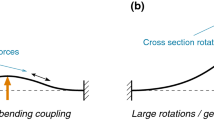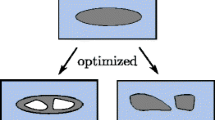Abstract
The creation of idealised, dimensionally reduced meshes for preliminary design and optimisation remains a time-consuming, manual task. A dimensionally reduced model is ideal for assessing design changes through modification of element properties without the need to create a new geometry or mesh. In this paper, a novel approach for automating the creation of mixed dimensional meshes is presented. The input to the process is a solid model which has been decomposed into a non-manifold assembly of smaller volumes with different meshing significance. Associativity between the original solid model and the dimensionally reduced equivalent is maintained. The approach is validated by means of a free-free modal analysis on an output mesh of a gas turbine engine component of industrial complexity. Extensions and enhancements to this work are also discussed.




















Similar content being viewed by others
References
Arabshahi S, Barton DC, Shaw NK (1993) Steps towards cad–fea integration. Eng Comput 9(1):17–26
Hamri O, Léon J-C, Giannini F, Falcidieno B (2010) Software environment for cad/cae integration. Adv Eng Softw 41(10–11):1211–1222
Gujarathi GP, Ma Y-S (2011) Parametric cad/cae integration using a common data model. J Manuf Syst 30(3):118–132
SIEMENS. Siemens plm software, July (2012). http://www.plm.automation.siemens.com/
Quadros WR, Owen SJ (2012) Defeaturing cad models using a geometry-based size field and facet-based reduction operators. Eng Comput 28(3):211–224
Sheffer A (2001) Model simplification for meshing using face clustering. CAD Comput Aided Des 33(13):925–934
Lee KY, Armstrong CG, Price MA, Lamont JH (2005) A small feature suppression/unsuppression system for preparing b-rep models for analysis. In: ACM symposium on solid modeling and applications, SM, pp 113–124
Li B, Liu J (2002) Detail feature recognition and decomposition in solid model. CAD Comput Aided Des 34(5):405–414
Thakur A, Banerjee AG, Gupta SK (2009) A survey of cad model simplification techniques for physics-based simulation applications. CAD Comput Aided Des 41(2):65–80
Samad WA, Suresh K (2011) Cad-integrated analysis of 3-d beams: a surface-integration approach. Eng Comput 27(3):201–210
Sheen DP, Son T, Myung D, Ryu C, Lee SH, Lee K, Yeo TJ (2010) Transformation of a thin-walled solid model into a surface model via solid deflation. Comput Aided Des 42(8):720–730
Chong CS, Senthil Kumar A, Lee KH (2004) Automatic solid decomposition and reduction for non-manifold geometric model generation. Comput Aided Des 36(13):1357–1369
Donaghy RJ, Armstrong CG, Price MA (2000) Dimensional reduction of surface models for analysis. Eng Comput 16(1):24–35
Blum H (1967) A transformation for extracting new descriptors of shape. Models for the Perception of Speech and Visual Form. MIT Press, Cambridge, pp 362–380
McCune RW, Armstrong CG, Robinson DJ (2000) Mixed-dimensional coupling in finite element models. Int J Numer Methods Eng 49(6):725–750
Makem JE, Armstrong CG, Robinson TT (2012) Automatic decomposition and efficient semi-structured meshing of complex solids. Eng Comput. doi:10.1007/s00366-012-0302-x
Robinson TT, Armstrong CG, Fairey R (2011) Automated mixed dimensional modelling from 2d and 3d cad models. Finite Elem Anal Des 47(2):151–165
CADfix. TranscenData, October (2012). http://www.transcendata.com/products/cadfix/
Lee SH, Lee K (2001) Partial entity structure: a compact non-manifold boundary representation based on partial topological entities, In: Proceedings of the sixth ACM symposium on Solid modeling and applications, pp 159–170
Luo X-J, Shephard MS, Yin L-Z, O’Bara RM, Nastasi R, Beall MW (2010) Construction of near optimal meshes for 3d curved domains with thin sections and singularities for p-version method. Eng Comput 26(3):215–229
Sheffer A, Bercovier M, Blacker T, Clements J (2000) Virtual topology operators for meshing. Int J Comput Geom Appl (Singapore) 10(3):309–331
Quadros WR , Shimada K, Owen SJ (2004) Skeleton-based computational method for the generation of a 3d finite element mesh sizing function. Eng Comput 20(3):249–264
Quadros WR, Vyas V, Brewer M, Owen SJ, Shimada K (2010) A computational framework for automating generation of sizing function in assembly meshing via disconnected skeletons. Eng Comput 26(3):231–247
Acknowledgments
The research leading to these results has received funding from the European Communitys Seventh Framework Programme (FP7/2007-2013) under grant agreement no. 234344 (http://www.crescendo-fp7.eu). The authors would like to thank the various partners for their support throughout the course of the work.
Author information
Authors and Affiliations
Corresponding author
Rights and permissions
About this article
Cite this article
Nolan, D.C., Tierney, C.M., Armstrong, C.G. et al. Automatic dimensional reduction and meshing of stiffened thin-wall structures. Engineering with Computers 30, 689–701 (2014). https://doi.org/10.1007/s00366-013-0317-y
Received:
Accepted:
Published:
Issue Date:
DOI: https://doi.org/10.1007/s00366-013-0317-y




